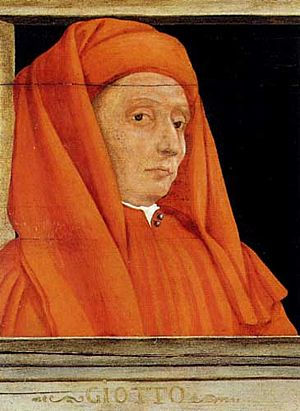(Florence 1266 - 1337)
Angel Giotto di Bondone, who was an Italian painter and architect of the Trecento, is considered as one of the first artists that contributed to the starting of the Italian Renaissance.
His master Cimabue found him in certain occasions drawing the sheep he pastured with coal when he was working as shepherd boy. 28 scenes of the life of Saint Francis were painted at his youth. Those scenes were painted for the upper part of the Church at Assisi, and the frescoes on the inferior part of the same church belong to a later period. He painted allegories of some virtues as Poverty, Chastity and Obedience and The Apotheosis of the Saints. Giotto worked in Rome towards the end of the XIII century and in 1298 he realized a mosaic.
Moreover, during that period he painted five scenes from Christ’s life in the platform of the Saint Peter’s Basilica, the biggest painting of the sacristy and some scenes of the Old and New Testament on its walls that nowadays do not exist. In the church of St. John Lateran there is a fresco that was painted by Giotto representing Pope Boniface VIII painted for the Jubilee of 1300. It seems that after his stay in Rome he painted the fresco Hell and Paradise, which nowadays is very damaged, in the Bargello Chapel.
In 1303, Giotto decorated the Scrovegni Chapel (also known as Arena Chapel) in Padua with frescoes that outstand for their excellent combination between painting and architecture. There we find scenes from the Old and New Testament, Ascension and in the base, we find allegorical scenes, which were the artists’ favourite ones in the XIV century.
In 1328 he was commissioned a portrait by Duke Charles of Calabria for the Palace of his lordship and it was thanks to the Duke that Giotto was called by King Albert to Naples (1330). Nevertheless, the paintings that are preserved there and that were attributed to him, in fact do not belong to him even showing his influence.
In 1334 he went back to Florence and was named architect of the Cathedral and of all the public buildings. He began the decorations of the façade and in 1336 he began to build the bell tower, but he died before it was finished. In the Brera Museum in Milan there is an altarpiece that represents the Virgin surrounded by angels.
He made innovations in both the techniques and the use of colours. He gave clarity and transparency to the colours and he introduced a moderate, wide and plastic distribution of light and shade into the pictorial art.
He lent an air of distinction to the proportions and he gave the figures a dynamic movement and expressive faces. He is one of the most brilliant Italian painters that changed the way of painting not only with variations in the method and in the processes but also with the creation of an ideal, the making of a new kind of art with a new expression, passion and life. He filled his works with his soft gift and replaced the monotonous clothing with other kind of clothing more suitable for age, situation and sex.


